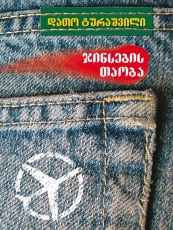FLIGHT FROM THE USSR
This novel is based on one of the most tragic events in 1980s Soviet Georgia. Seven young people hijacked an airplane in an attempt to escape the Soviet Union. This was an exceptional event: at that time even the thought of escape was criminal. The Soviet government sentenced most of the protagonists to death. Public opinion was split. Some considered them to be just ordinary terrorists. Others argued that living under the Soviet regime was so unbearable that the hijacking of the plane was justified. Flight from the USSR lets the reader closely follow the leading characters, and learn more about their motives and aspirations. The novel has been adapted to the stage, and is one of the most successful productions of the “Georgian Free Theatre”.
EXTRACT
Translated into English by Maya Kiasashvili and Clare Askew
“These blue days and this sunshine of childhood”...
Antonio Machado’s last words
Preface
On publishing this book, I did not consider its relevance in today’s current political climate, rather, I naively believed that after the disintegration of the USSR, the Soviet past of Georgia would become nothing but a bitter memory. I was wrong. As it turned out, the past can come back to haunt you, especially if we ourselves cannot move away from it. We have distanced ourselves from a country and its times, but failed to alter the mindset instilled, while being part of what was called the Empire of Evil, where benevolence was scarce, the space pioneer superpower failed to produce a simple item of clothing such as jeans. What could be more innocent than a pair of jeans? Because these could never be authentically replicated, the Soviet Union decided to ban their existence. The banned jeans became sweeter than the forbidden fruit. The Soviet youth was determined to acquire them at any cost and, unsurprisingly, smuggling flourished. Occasionally, there would be a pair of genuine US-branded jeans among the stock smuggled from all over the world. In those days, every pair of jeans was believed to be American and, as the Soviet propaganda was set on destroying American values, many associated happiness with where jeans were thought to be in abundance. There may have been some truth in this due to the simple fact that the Soviet State denied citizens their basic civil rights, the right to property among them. One could truly be free only in one’s grave or, rather, the authorities would stop worrying about restricting your freedom only once you were safely 6 feet under. Even official “atheistic monitors” knew that sooner or later they, too, would be laid to rest in the very same ground, herefore no one was denied the right to their own grave. There may have been other reasons, but a grave was the only property people were allowed to own. Such political ttitudes marked the beginning of an altered Georgian mentality, unfortunately, for the worse. For centuries, the traditional Georgian graveyards were simple and modest, while in Soviet times the graves became overly decorated, adorned with marble tables and benches, statues, bikes and even cars. The Soviet Georgians were confident in one thing only – the grave belonged to them, therefore they were zealously taken care of and protected. People built and decorated them as if they were real estate property. The authorities turned a blind eye to the graveyard eccentricities. Soviet regime principles had not extended to the Georgian graveyards. The Georgian authorities demonstrated more respect to the dead than to the living. However, there was one prerequisite for a guaranteed grave - one had to die naturally...
(See PDF)
In case of using the information, please, indicate the source.
